
Lecture 2
Physiology
Dr.Affan Ezzat
1
Factors That Affect the Net Rate of Diffusion
What is usually important is the net rate of diffusion of a substance in the desired direction. This net
rate is determined by several factors.
(1)Effect of Concentration Difference on Net Diffusion through a Membrane.
The rate at which the substance diffuses inward is proportional to the concentration of molecules on the
outside, because this concentration determines how many molecules strike the outside of the membrane
each second. Conversely, the rate at which molecules diffuse outward is proportional to their
concentration inside the membrane. Therefore, the rate of net diffusion into the cell is proportional to
the concentration on the outside minus the concentration on the inside, or: Net diffusion μ (Co - Ci)
in which Co is concentration outside and Ci is concentration inside.
(2)Effect of Membrane Electrical Potential on Diffusion of Ions—The “Nernst Potential.”
If an electrical potential is applied across the membrane, the electrical charges of the ions cause them
to move through the membrane even though no concentration difference exists to cause movement.
Thus, the concentration of negative ions is the same on both sides of the membrane, but a positive
charge has been applied to the right side of the membrane and a negative charge to the left, creating an
electrical gradient across the membrane. The positive charge attracts the negative ions,whereas the
negative charge repels them. Therefore, net diffusion occurs from left to right. After much time, large
quantities of negative ions have moved to the right, creating the condition in which a concentration
difference of the ions has developed in the direction opposite to the electrical potential difference. The
positive charge attracts the negative ions, whereas the negative charge now tends to move the ions to
the left, while the electrical difference tends to move them to the right. When the concentration
difference rises high enough, the two effects balance each other. At normal body temperature (37°C),
the electrical difference that will balance a given concentration difference of univalent ions—such as
sodium (Na+) ions—can be determined from the following formula, called the
Nernst equation:
which EMF is the electromotive force (voltage) between side 1 and side 2 of the membrane, C1 is in
the concentration on side 1, and C2 is the concentration on side 2. This equation is extremely important
in understanding the transmission of nerve impulses.
(3)Effect of a Pressure Difference across the Membrane.
Pressure means the sum of all the forces of the different molecules striking a unit surface area at a
given instant. Therefore, when the pressure is higher on one side of a membrane than on the other, this
means that the sum of all the forces of the molecules striking the channels on that side of the membrane
is greater than on the other side. The result is that increased amounts of energy are available to cause
net movement of molecules from the high-pressure side toward the low-pressure side.
At times,
considerable pressure difference develops between the two sides of a diffusible membrane. This occurs,
for example, at the blood capillary membrane in all tissues of the body. The pressure is about 20 mm
Hg greater inside the capillary than outside.
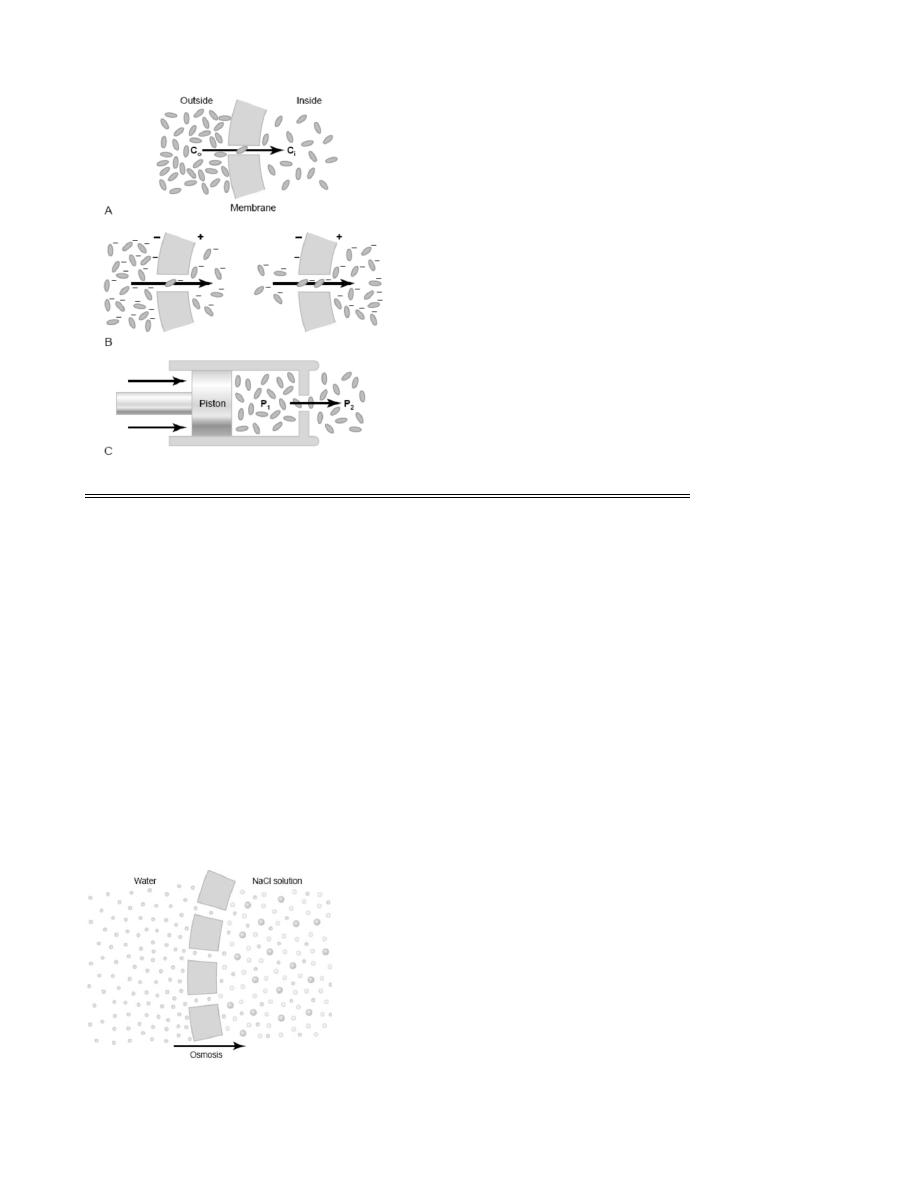
Lecture 2
Physiology
Dr.Affan Ezzat
2
Osmosis Across Selectively Permeable Membranes— “Net Diffusion” of Water
The most abundant substance that diffuses through the cell membrane is water. Normally, the amount
that diffuses in the two directions is balanced so precisely that zero net movement of water occurs.
Therefore, the volume of the cell remains constant. However, under certain conditions, a concentration
difference for water can develop across a membrane, just as concentration differences for other
substances can occur. When this happens, net movement of water does occur across the cell membrane,
causing the cell either to swell or to shrink, depending on the direction of the water movement. This
process of net movement of water caused by a concentration difference of water is called osmosis.
To give an example of osmosis, with pure water on one side of the cell membrane and a solution of
sodium chloride on the other side. Water molecules pass through the cell membrane with ease, whereas
sodium and chloride ions pass through only with difficulty. Therefore, sodium chloride solution is
actually a mixture of permeant water molecules and nonpermeant sodium and chloride ions, and the
membrane is said to be selectively permeable to water but much less so to sodium and chloride ions.
Yet the presence of the sodium and chloride has displaced some of the water molecules on the side of
the membrane where these ions are present and, therefore, has reduced the concentration of water
molecules to less than that of pure water. As a result more water molecules strike the channels on the
left side, where there is pure water, than on the right side, where the water concentration has been
reduced. Thus, net movement of water occurs from left to right—that is, osmosis occurs from the pure
water into the sodium chloride solution.
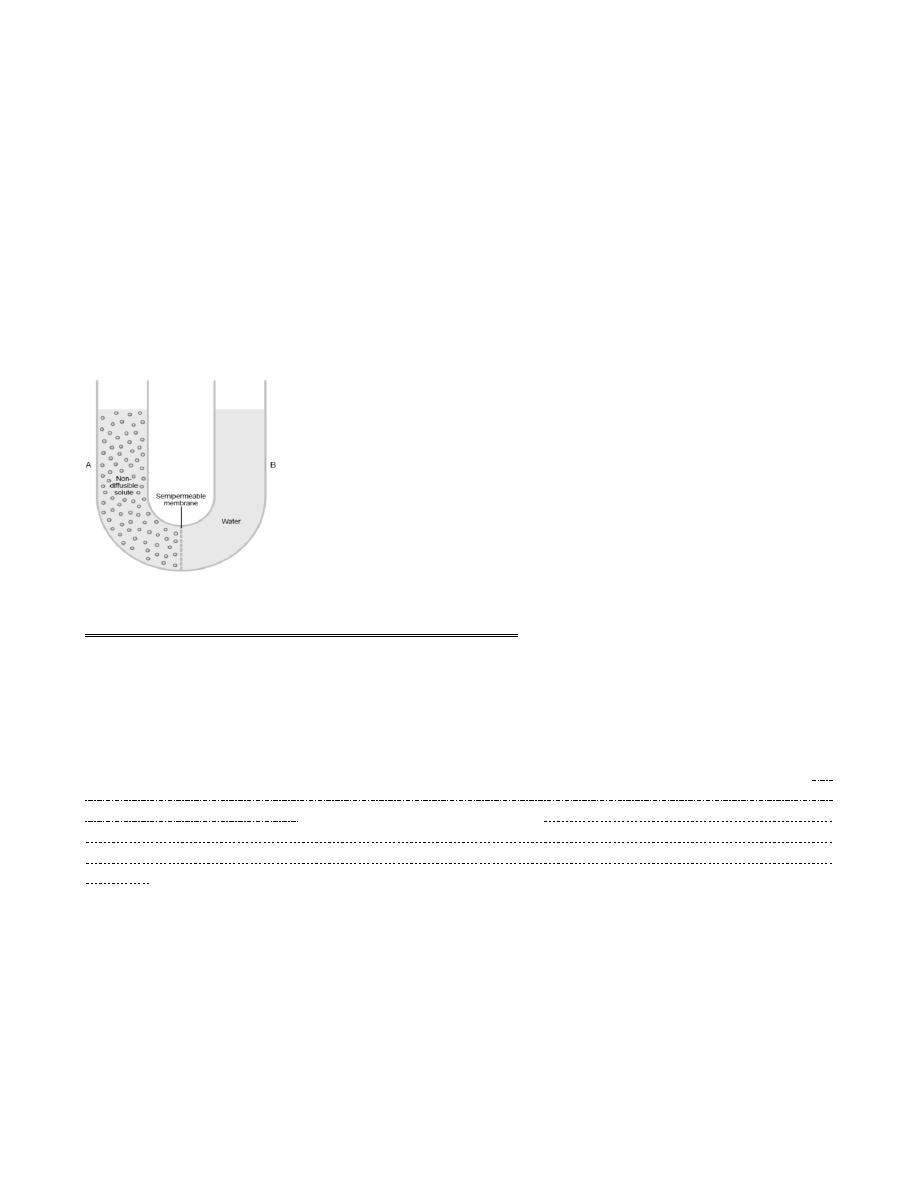
Lecture 2
Physiology
Dr.Affan Ezzat
3
Osmotic Pressure
If pressure were applied to the sodium chloride solution, osmosis of water into this solution would be
slowed, stopped, or even reversed. The exact amount of pressure required to stop osmosis is called the
osmotic pressure of the sodium chloride solution.
A selectively permeable membrane separating two columns of fluid, one containing pure water and the
other containing a solution of water and any solute that will not penetrate the membrane. Osmosis of
water from chamber B into chamber A causes the levels of the fluid columns to become farther and
farther apart, until eventually a pressure difference develops between the two sides of the membrane
great enough to oppose the osmotic effect. The pressure difference across the membrane at this point is
equal to the osmotic pressure of the solution that contains the nondiffusible solute.
The osmotic pressure exerted by particles in a solution, whether they are molecules or ions, is
determined by the number of particles per unit volume of fluid, not by the mass of the particles. The
reason for this is that each particle in a solution, regardless of its mass, exerts, on average, the same
amount of pressure against the membrane.
“Active Transport” of Substances Through Membranes
When a cell membrane moves molecules or ions “uphill” against a concentration gradient (or “uphill”
against an electrical or pressure gradient), the process is called active transport. Different substances
that are actively transported through at least some cell membranes include sodium ions, potassium ions,
calcium ions, iron ions, hydrogen ions, chloride ions, iodide ions, urate ions, several different sugars,
and most of the amino acids.
Active transport is divided into two types according to the source of the energy used to cause the
transport: primary active transport and secondary active transport. In primary active transport, the
energy is derived directly from breakdown of adenosine triphosphate (ATP) or of some other high-
energy phosphate compound. In secondary active transport, the energy is derived secondarily from
energy that has been stored in the form of ionic concentration differences of secondary molecular or
ionic substances between the two sides of a cell membrane, created originally by primary active
transport. In both instances, transport depends on carrier proteins that penetrate through the cell
membrane, as is true for facilitated diffusion. However, in active transport, the carrier protein functions
differently from the carrier in facilitated diffusion because it is capable of imparting energy to the
transported substance to move it against the electrochemical gradient.
Sodium-Potassium Pump as an example of Primary Active Transport:
The active transport mechanism that has been studied in greatest detail is the sodium-potassium (Na+-
K+) pump, a transport process that pumps sodium ions outward through the cell membrane of all cells
and at the same time pumps potassium ions from the outside to the inside. This pump is responsible for
maintaining the sodium and potassium concentration differences across the cell membrane, as well as
for establishing a negative electrical voltage inside the cells. This pump is also the basis of nerve
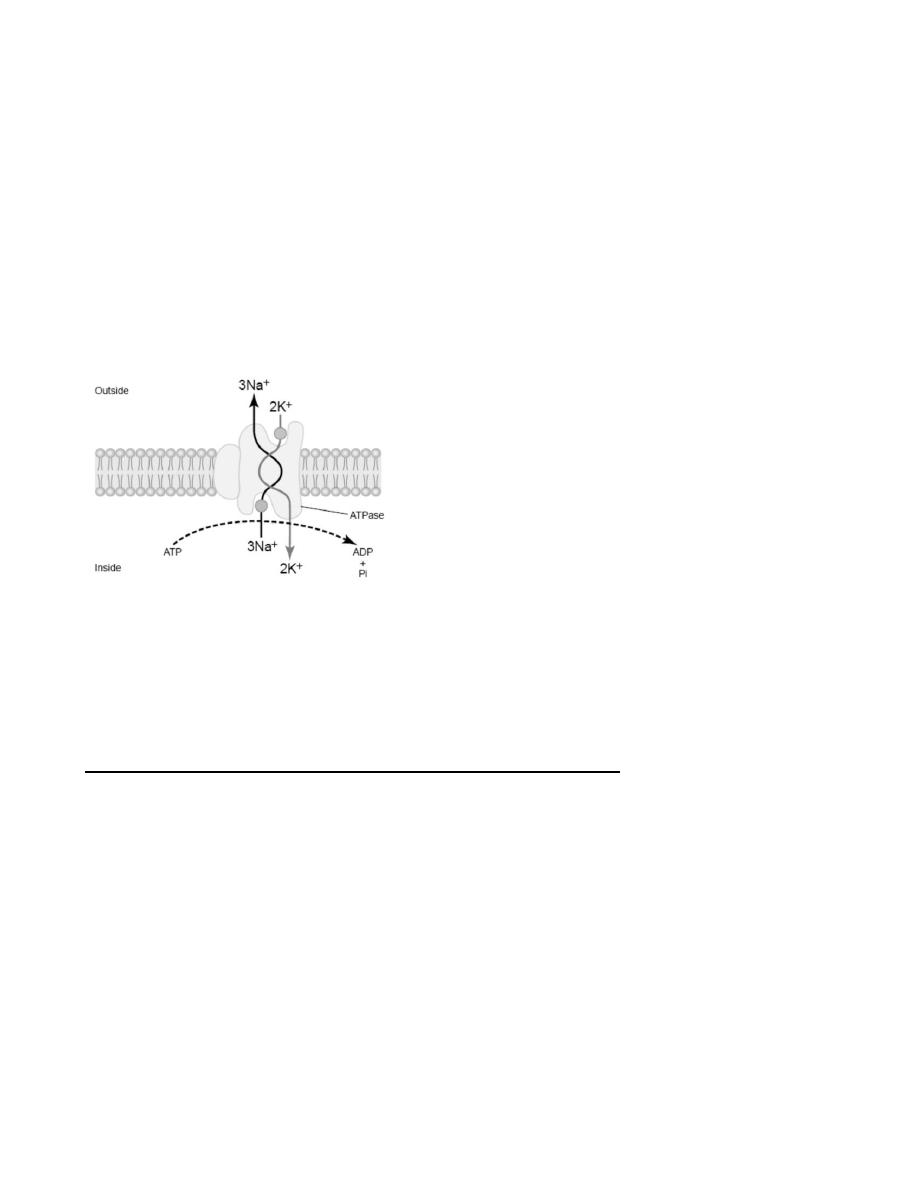
Lecture 2
Physiology
Dr.Affan Ezzat
4
function, transmitting nerve signals throughout the nervous system. The carrier protein is a complex of
two separate globular proteins: a larger one called the a subunit, and a smaller one called the b
subunit, the larger protein has three specific features that are important for the functioning of the pump:
1. It has three receptor sites for binding sodium ions on the portion of the protein that protrudes to the
inside of the cell.
2. It has two receptor sites for potassium ions on the outside.
3. The inside portion of this protein near the sodium binding sites has ATPase activity.
When two potassium ions bind on the outside of the carrier protein and three sodium ions bind on the
inside, the ATPase function of the protein becomes activated. This then cleaves one molecule of ATP,
splitting it to adenosine diphosphate (ADP) and liberating a high-energy phosphate bond of energy.
This liberated energy is then believed to cause a chemical and conformational change in the protein
carrier molecule, extruding the three sodium ions to the outside and the two potassium ions to the
inside. For some cells, such as electrically active nerve cells, 60 to 70 per cent of the cells’ energy
requirement may be devoted to pumping Na+ out of the cell and K+ into the cell.
Electrogenic Nature of the Na+-K+ Pump.
The fact that the Na+-K+ pump moves three Na+ ions to the exterior for every two K+ ions to the
interior means that a net of one positive charge is moved from the interior of the cell to the exterior for
each cycle of the pump. This creates positivity outside the cell but leaves a deficit of positive ions
inside the cell; that is, it causes negativity on the inside. Therefore, the Na+-K+ pump is said to be
electrogenic because it creates an electrical potential across the cell membrane. This electrical potential
is a basic requirement in nerve and muscle fibers for transmitting nerve and muscle signals.
Secondary Active Transport— Co-Transport and Counter-Transport
When sodium ions are transported out of cells by primary active transport, a large concentration
gradient of sodium ions across the cell membrane usually develops—high concentration outside the
cell and very low concentration inside. This gradient represents a storehouse of energy because the
excess sodium outside the cell membrane is always attempting to diffuse to the interior. Under
appropriate conditions, this diffusion energy of sodium can pull other substances along with the sodium
through the cell membrane. This phenomenon is called co-transport; it is one form of secondary active
transport.
For sodium to pull another substance along with it, a coupling mechanism is required. This is achieved
by means of still another carrier protein in the cell membrane.
The carrier in this example serves as an attachment point for both the sodium ion and the substance to
be co-transported. Once they both are attached, the energy gradient of the sodium ion causes both the
sodium ion and the other substance to be transported together to the interior of the cell. In counter-
transport, sodium ions again attempt to diffuse to the interior of the cell because of their large
concentration gradient. However, this time, the substance to be transported is on the inside of the cell
and must be transported to the outside. Therefore, the sodium ion binds to the carrier protein where it
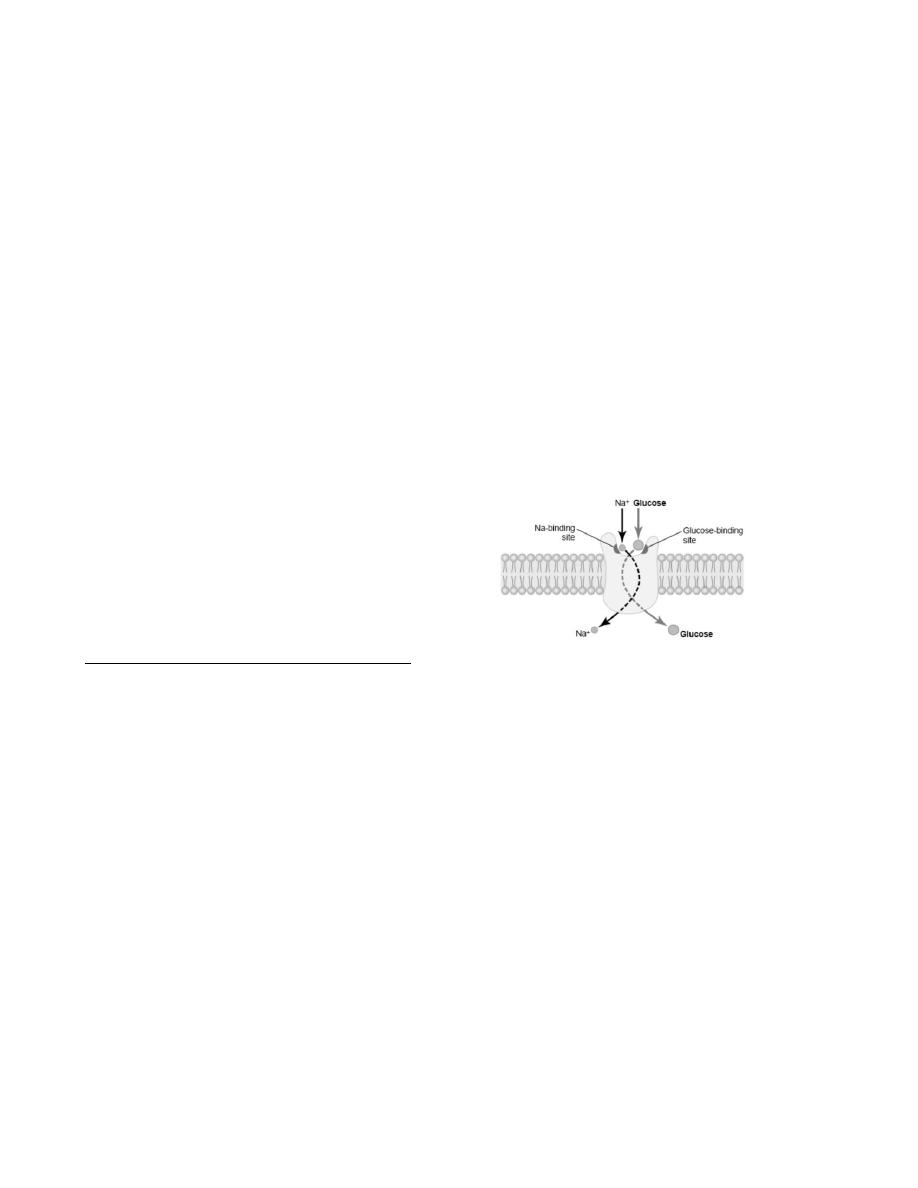
Lecture 2
Physiology
Dr.Affan Ezzat
5
projects to the exterior surface of the membrane, while the substance to be counter-transported binds to
the interior projection of the carrier protein. Once both have bound, a conformational change occurs,
and energy released by the sodium ion moving to the interior causes the other substance to move to the
exterior.
Co-Transport of Glucose and Amino Acids Along with Sodium Ions
Glucose and many amino acids are transported into most cells against large concentration gradients; the
mechanism of this is entirely by co-transport. Note that the transport carrier protein has two binding
sites on its exterior side, one for sodium and one for glucose. Also, the concentration of sodium ions is
very high on the outside and very low inside, which provides energy for the transport. A special
property of the transport protein is that a conformational change to allow sodium movement to the
interior will not occur until a glucose molecule also attaches. When they both become attached, the
conformational change takes place automatically, and the sodium and glucose are transported to the
inside of the cell at the same time. Hence, this is a sodium-glucose co-transport mechanism. Sodium
co-transport of the amino acids occurs in the same manner as for glucose, except that it uses a
different set of transport proteins. Five amino acid transport proteins have been identified, each of
which is responsible for transporting one subset of amino acids with specific molecular characteristics.
Sodium co-transport of glucose and amino acids occurs especially through the epithelial cells of the
intestinal tract and the renal tubules of the kidneys to promote absorption of these substances into
the blood. Other important co-transport mechanisms in at least some cells include co-transport of
chloride ions, iodine ions, iron ions, and urate ions.
Active Transport Through Cellular Sheets
At many places in the body, substances must be transported all the way through a cellular sheet instead
of simply through the cell membrane. Transport of this type occurs through the (1) intestinal
epithelium, (2) epithelium of the renal tubules, (3) epithelium of all exocrine glands, (4) epithelium of
the gallbladder, and (5) membrane of the choroid plexus of the brain and other membranes.
The basic mechanism for transport of a substance through a cellular sheet is (1) active transport
through the cell membrane on one side of the transporting cells in the sheet, and then (2) either simple
diffusion or facilitated diffusion through the membrane on the opposite side of the cell. A mechanism
for transport of sodium ions through the epithelial sheet of the intestines, gallbladder, and renal tubules.
This figure shows that the epithelial cells are connected together tightly at the luminal pole by means of
junctions called“kisses.” The brush border on the luminal surfaces of the cells is permeable to both
sodium ions and water. Therefore, sodium and water diffuse readily from the lumen into the interior of
the cell. Then, at the basal and lateral membranes of the cells, sodium ions are actively transported into
the extracellular fluid of the surrounding connective tissue and blood vessels. This creates a high
sodium ion concentration gradient across these membranes, which in turn causes osmosis of water as
well. Thus, active transport of sodium ions at the basolateral sides of the epithelial cells results in
transport not only of sodium ions but also of water. These are the mechanisms by which almost all the
nutrients, ions, and other substances are absorbed into the blood from the intestine; they are also the
way the same substances are reabsorbed from the glomerular filtrate by the renal tubules.
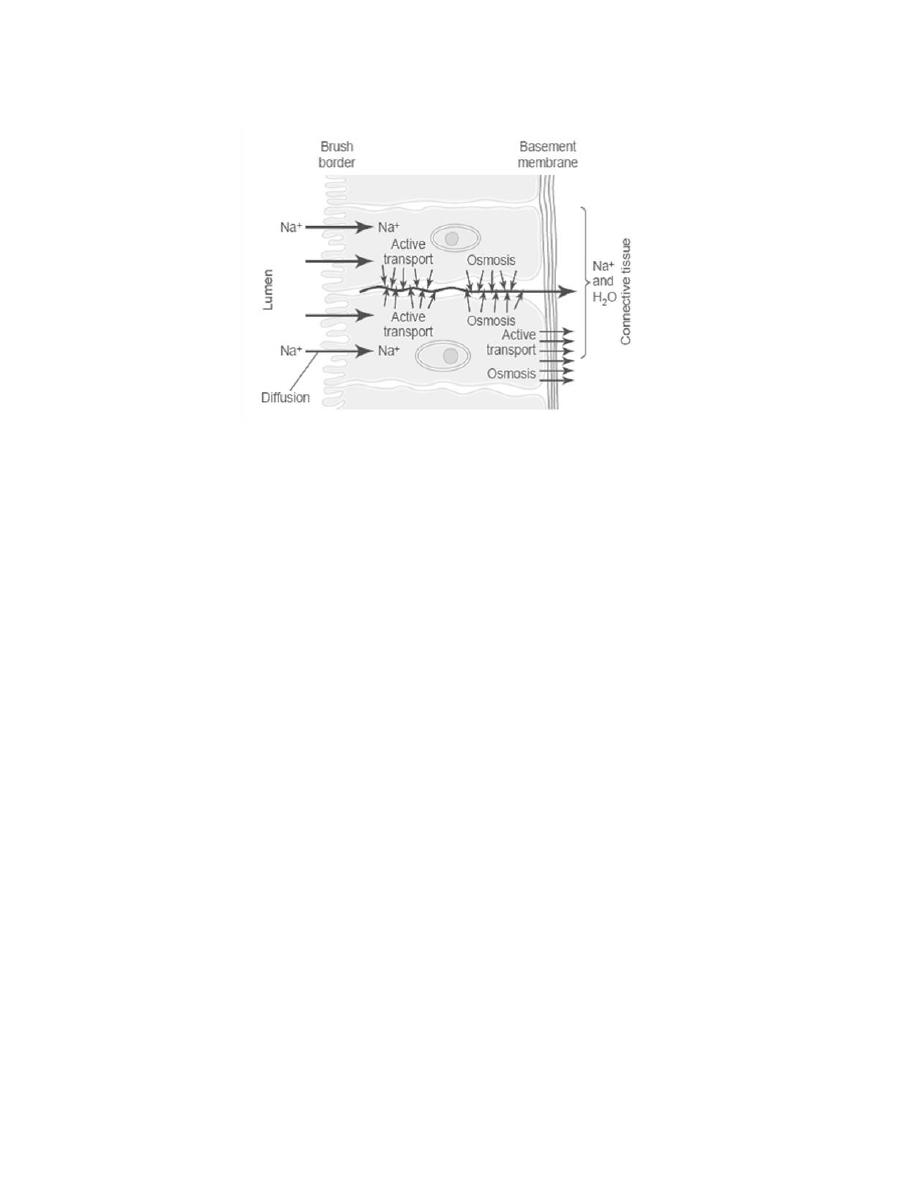
Lecture 2
Physiology
Dr.Affan Ezzat
6
